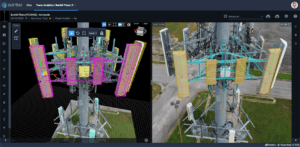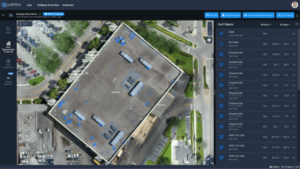



- Dan Ciprari is CEO of Pointivo, the company providing the algorithms and technology behind some of the largest in-house drone-based asset inspection programs in the country. As Pointivo expands their portfolio to include complete products sold under their own label, the Pointivo name is becoming more prevalent in asset inspection and data analytics.


Dan Ciprari, CEO Pointivo
DRONELIFE had the opportunity to speak with Dan about how Pointivo developed, why he chose to invest in drone technology, and how the space is evolving.
Analytics: the Biggest Challenge, the Biggest Value Add
Dan had sold a previous venture and was in “give-back mode,” coaching other entrepreneurs with a local incubator at Georgia Tech’s Advanced Technology Development Center, ATDC, when he met Pointivo co-founder Habib Fathi, now the Chief Science Officer, leading Pointivo’s AI team. Fathi invented Pointivo’s foundational capabilities before commercial drone use became mainstream: integrating computer vision and AI/ML to accelerate processes around asset inspection, applying those concepts to structural systems. The company holds patents on several core capabilities: from capturing data, building accurate models, and analyzing and presenting results in useful and valuable ways.
“We started working on cell phone capture, scanning a room or a house for estimates on siding or window replacements,” Dan explained. “We began with the ability to extract structure from imagery, and eventually learned how to extract conditions and other data from that imagery.”
“When drones came into play, we knew the analytics were going to be the biggest challenge – and the biggest value add. Drone imagery opened up much larger enterprise markets like roofing, insurance, telecom, solar, construction, infrastructure.”
“In those early days, everyone focused on how to fly drones and how to capture data: but our focus was to provide analytics. Pointivo was contacted by a premier drone service provider early on, and we white-labeled or sat behind many of the early drone portals and platforms as their analytics provider.”
Investing in Drone Technology
Dan says as drones became viable in the commercial market, the team realized that they would be an excellent capture device. Investing in Pointivo checked all of the boxes for a great opportunity. “For me, investing in this software platform met all of my critical criteria for what I wanted to do next. There was a large market opportunity for the technology, but we were a first mover, with lots of room to develop new IP and patents,” he said. “We could be innovative, pushing the edge of what was previously possible. And Habib was the perfect co-founder: super intelligent, ethical, and works incredibly hard.”
That early decision to move forward led to Pointivo being part of many of the earliest proof of concept projects for drones, with their technology deployed in multiple industries with Fortune 500 companies and drone ecosystem leaders.
Why Drone-Enabled Asset Inspection Will Be the New Normal
Drone data analytics and asset inspection is a relatively new field. In recent months, however, adoption in traditional industries has grown: and Dan says that will only continue. “In the physical asset inspection space, drone capture is ideally suited for situations with real pains in manual processes,” he said. “Manual processes are often expensive, error-prone, and can be dangerous. There are always very hard-to-reach areas when inspecting a physical asset. It’s painful to gather data between handwritten reports, speadsheets, and images: and it’s challenging to share across diverse teams.
“These pains are real operational issues – and our solutions solve them all. Workforce shortages have become a real issue too: with more work and fewer people, reliable partners and easy-to-use automated platforms are essential. Our tenure in automating AI-driven analytics has helped us create a game-changing platform, and one demo shows the difference.”

 Pointivo has deployed solutions in many different industries. For solar system design, Pointivo generates engineering as-built drawings of roofs including all installed equipment, their heights, parapet walls, and surrounding vegetation. “Estimators fly a drone instead of climbing a roof, and by the time they get back to the office, the roof CAD is in their design software ready to complete their solar designs: it’s super accurate, and it’s fast,” Dan explained. “Digital twins enable designers to virtually go back to the site from their desk to resolve any outstanding questions.”
Pointivo has deployed solutions in many different industries. For solar system design, Pointivo generates engineering as-built drawings of roofs including all installed equipment, their heights, parapet walls, and surrounding vegetation. “Estimators fly a drone instead of climbing a roof, and by the time they get back to the office, the roof CAD is in their design software ready to complete their solar designs: it’s super accurate, and it’s fast,” Dan explained. “Digital twins enable designers to virtually go back to the site from their desk to resolve any outstanding questions.”
The opportunities for drone-based asset inspection are endless, and Pointivo has worked in many of them: inspecting offshore equipment, or dangerous flare stacks in the oil and gas industry; automating inventory and conditional assessment inspections of transmission towers for some of the largest utilities in the world; providing consistent, unbiased conditional assessments of commercial roofs and facades.
“In the telecom space, identifying revenue opportunities is a very hot topic now: but we’ve been doing it for years,” said Dan. “We fly a cell tower, develop a digital twin and all its components, compare it to existing contracts, and identify where revenue is mismatched with what is deployed. Tower owners are gaining millions of dollars using our solution; we are analyzing 10s of thousands of towers per year.”
“We can also identify unused space on the tower, verify its dimensions, allow the tower owner and their customers to visualize that space, mock up additional installations, and view the surrounding area, all using previously-captured data.”
The Next Evolution of AI-Enabled Asset Inspection
Asked how he sees the space evolving, Dan paints a picture of new levels of automation, leveraging the internet of things. “Enterprise customers are going to require another level of automation to justify ROI. They want to know that drone programs don’t just provide better data but also deliver results they can quantify,” Dan said. “We already see that customers want to see outputs that accelerate their existing business processes – they want to avoid another platform to learn or spend time in. In the future, our solution (and the industry) will be nearly fully automated.”
With the rise of Drone in a Box (DIAB) solutions, Pointivo sees drone deployments strategically place to provide full geographic coverage of infrastructure and other assets. Drone flights will be fully automated: and analytics engines will determine what happens next: whether to 1) simply log the data and analysis and store it, 2) initiate a service call or follow-up event to address identified issues, or 3) send an alert for human review of results in real-time or asynchronously.
“People will be relieved from repetitive inspection-related tasks through advances in AI-driven analytics,” Dan said. “People will get involved only when there is an exception that the AI engine cannot resolve.”
Lessons Learned
As a CEO of a company in an emerging sector, Dan has had the opportunity to see which companies adopt new technology – and which ones won’t. “You really have to listen to the customer – when in new emerging markets, the customer often wants to learn from us, the perceived experts in the space. Still, we must listen to whether they are experiencing the pain points we expect or if it is something else,” said Dan. “We have spent lots of time with companies that are not ready or not a great cultural fit for new technologies. But we are partnered with some great companies fully vested in leading their industries. These companies have the foresight to realize the ROI possible with a properly implemented drone-based solution.”
“You have to be flexible, and meet the customer where they are – we are working with innovators, game changers, and slow-to-change organizations; they need different things and require different approaches. It’s critical to meet customers where they are, instead of applying the one-size-fits-all mindset.”
“Also, trusting your team is critical. We have a great group of dedicated and super-smart team members who genuinely believe we are on the right path and are fully committed to ensuring customer success.”
Miriam McNabb is the Editor-in-Chief of DRONELIFE and CEO of JobForDrones, a professional drone services marketplace, and a fascinated observer of the emerging drone industry and the regulatory environment for drones. Miriam has penned over 3,000 articles focused on the commercial drone space and is an international speaker and recognized figure in the industry. Miriam has a degree from the University of Chicago and over 20 years of experience in high tech sales and marketing for new technologies.
For drone industry consulting or writing, Email Miriam.
TWITTER:@spaldingbarker
Subscribe to DroneLife here.
See Also
Tags: asset inspectionautomated inspectionsdata analyticsdrone datadrone inspectionsPointivo





Related Posts
Blue Marble Shows How AI and LiDAR Deliver ROI for Rail Operators
First Breach and ideaForge Establish US Drone Manufacturing Partnership
Tennessee Drone and AAM Symposium Discusses Future of Mobility